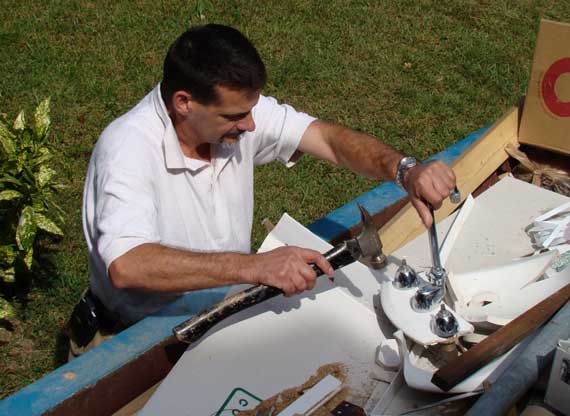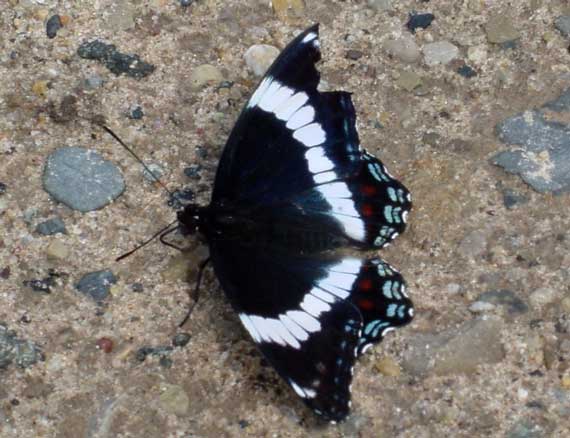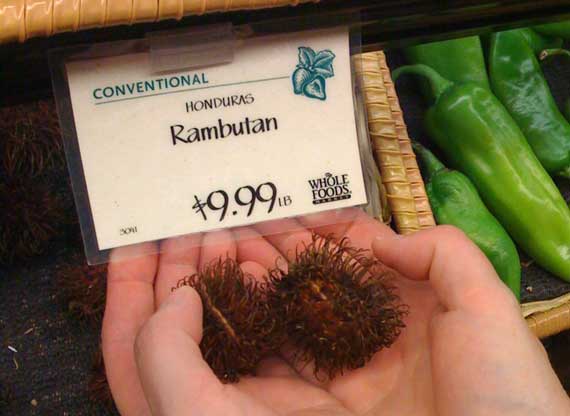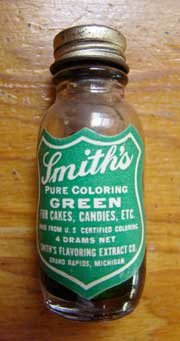Musings

I keep forgetting to mention that being a builder means you get lovely opportunities to expend your aggressions. Here DW separates our old sink fixture from the old sink that it had fused to. This way we can reuse it (cross your fingers).
Recipe alert: fast BBQ Tofu explained here.
Posted at 12:22 PM |
1 Comment »

Yes, I know this is dill….
On more than one occasion, I have thought that Mark Bittman has made an astute observation about food and flavors and cooking.
I don’t get this, though. He says “at a quick glance” lavender and rosemary “resemble each other”.
NOT! (says The Botanist’s daughter…)
Posted at 8:37 AM |
Comments Off on Morphological similarities?

You may think the most ubiquitous ancillary equipment used by Hispanic workmen in this area is the boombox (shown here).
You’d be wrong.
It’s a microwave. For lunch. No kidding.
Posted at 12:27 PM |
1 Comment »

Archive photo from several summers back, in northern Michigan, and, no, I don’t know what kind it is….
So, which is it?
When opening a can of, say, beans, I always wipe the top of the can off before engaging the can opener.
Posted at 8:22 PM |
5 Comments »
I guess I’m convinced that I was the victim of misinformation: turns out coffee at normal levels of consumption is not a diuretic.
In other dietary data: the NYTimes says beets (Beta vulgaris) are the new spinach. BTW, chard is botanically a leafy beet or a small-rooted beet (depending on how you look at it), and they’re both in the amaranth/chenopodium family, which has lots of species people have harvested and cultivated, including quinoa, huazontle, and epazote, all of which I find quite tasty….
Hmm, dinner tonight: soup, but maybe without any type of Amaranthaceae….
Posted at 4:20 PM |
Comments Off on Link-crazy!

This is Seattle’s harbor; I haven’t been to SF in years.
Morning Edition today had the story of how Rice-a-roni came about, a result fortuitous intersection of an improbable set of lives. The original recipe for vermicelli-rice came from Pailadzo Captanian, an Armenian genocide survivor who resettled in San Francisco.
I never would have guessed; I would have said it was developed in a commercial kitchen.
The link above includes the “Pilaff” recipe and has photos of the Captanian family’s recipe cards.
Posted at 12:03 PM |
Comments Off on Rice-a-roni

For the first time that I’m aware of, I beheld real, raw, unprocessed rambutan. I have eaten freeze-dried and canned versions, but not laid hands on the real thing. Didn’t buy/eat it, though….
They are pretty light in heft, so I wouldn’t have been entirely extravant if I had bought this pair…. Just wasn’t in the mood, I guess. Perhaps next time….
Posted at 9:27 AM |
Comments Off on Raw rambutan

The spice rack in the cabin still harbors ancient containers. Some are less than about 30 years old or so (within my memory), and a few are older.
For some reason, this is the only food coloring that survives—maybe because (for historical reasons) we call this place the Green Cottage?
I am so not a baker these days, but I remember that Mom made lots of cakes and cookies (sweets are cheap calories?). She liked Jiffy mixes (Chelsea’s best!), but more often cooked from scratch.
I remember making cupcakes more than once, but I don’t remember making pies, or eating them, when we were up north—maybe because cakes and cookies are easier to make in hot, humid weather?
BTW, my quick Google of Smith’s Flavoring Extract Company, of Grand Rapids, didn’t turn up anything. I’m still trying to decide when this label was probably last used…. My guess is the bottle was probably purchased at Rahilly’s grocery, now an IGA….
Posted at 3:23 PM |
1 Comment »

I count myself as extremely lucky to have made it to the UP for the famed Mills Fourth of July Party. I had thought on Tuesday morning that the odds were definitely against it. What a difference a day makes!
So, here we are, ensconced in the cottage (aka cabin) in Luce County. We were lucky when arrived to discover that all JCB’s labors last year to better seal the place (especially where the foundation and the wood/house meet) made a huge difference—meaning far less cleaning to make the place habitable. No sign of bats. Only a couple small, localized evidences of mouse activity. And, which I didn’t expect, far less miscellaneous dusty, grimy bits left by insects, especially spiders. Don’t get me wrong, I really don’t have anything against bats, mousies (especially large Mousies!), and (most) insects, but I prefer them to reside in places other than where I sleep.
I have stashed in the fridge our contribution to the potluck party. It’s my version of a three-bean salad meets tabouli. The three beans are edamame, garbanzo, and black. I put in three grains: barley, wild rice, and brown rice. I added lots of chopped veggies, including carrots, celery, cucumber, and green onion. The dressing is lemon juice, olive oil, salt, and pepper, and the whole dish is rounded out with some fresh garlic and chopped parsley. I thought about adding some fresh oregano, but liked what I had without, so there it is.
[Extra points if you spotted the stink bug when you looked at the picture….]
Posted at 12:32 PM |
2 Comments »

Counterpoint photo. And the ingredient coconut sport is…?*
This is a civics moment (well, okay, more than a moment).
Go to this page to download the RAND report After Saddam: Prewar Planning and the Occupation of Iraq, which focuses on the period 1 May 2003 through 30 June 2004, a mere 13 months of the years our military has been there. This report is paid for by your tax dollars, filtered through the US Army.
The United States did not plan well for the complexities and violence of post-Saddam Iraq. Although many U.S. government agencies invested a lot of time and effort in identifying possible reconstruction requirements for postwar Iraq, the basic plan for war largely pushed these requirements aside. Indeed, in overlooking the need to enforce security in the immediate aftermath of Saddam’s fall, the warplan may well have contributed to the problems U.S. forces face. (p. 233)
In short, the heavy hand of the Bush administration messes it up for all of us. Big time.
In the end, the Army advises itself:
Planners must start with strategic guidance from the civilian leadership on where they want to be, strategically, when the war ends. They can then work backward to points of major conflict, shaping plans for those in ways that contribute to the larger and longer-term strategic goal. (p. 242)
The RAND report is not the same document as the nearly 600 page (plus appendices, timelines, etc.) On Point II: Transition to the New Campaign. That document was released yesterday by the Army’s Combined Arms Center, formed in late 2005 at, of all places, Fort Leavenworth (and also paid for by your tax dollars). Download On Point II here (it’s a big file and takes a while even with broadband). (The cover art rather jarringly focuses on people and patriotism.) This one is billed on the web page as:
…the US Army’s first historical study of its campaign in Iraq in the decisive eighteen months following the overthrow of the Baathist regime in April 2003.
It is essentially the Army’s critical review of itself, and is based on interviews of officers. The timeframe begins with Bush’s announcement that major combat operations were complete. That was in May 2003. Yeah, over five years ago.
The difficulty in Iraq in April and May 2003 for the Army, and the other Services, was that the transition to a new campaign was not well thought out, planned for, and prepared for before it began. Additionally, the assumptions about the nature of post-Saddam Iraq on which the transition was planned proved to be largely incorrect. (p. 568)
What the occupation forces had to deal with was a changing situation, changing on many fronts, including non-military ones. And their decision-making apparatus was not structured to deal with a constantly changing situation. Hence, the analysis focuses on transition (On Point II, p. 7: “A central theme emerging from this work is transition.”). I daresay an army that is constantly reinventing itself is ill-prepared to deal with the big picture.
Analysis is good. But we’re all, including the Iraqis, stuck with the outcome of a long series of bad decisions. There’s really no significant way to penalize the Deciders who brought this about. In this country, we citizens hand over decision-making to various officials, some we vote on and many we have no hand in choosing, and we really don’t have much input after that. (And the cynical side of me wants to add that if you take the time to read the concluding chapters of each of these documents, and really think about them, you may have spent more time than the Shrub did really thinking about getting us into this mess—meetings don’t count.)
This is a long enough entry for now. But one more thing: I do not think that the child of an anthropologist would have done this.
* Apparently “coconut sport” is English for macapuno, in small type on the label. This web page says that macapuno are aberrent coconuts, commonly associated with the Philippines, that lack milk and have gelatinous meat. Commenters concur that the bottled version is a poor imitation of the fresh, “real thang.” Here’s good general info on coconuts. And, from Wikipedia, “Fresh inner coconut husk can be rubbed on the lens of snorkelling goggles to prevent fogging during use.” Who knew?
Posted at 8:55 AM |
Comments Off on Decision-making strategies









